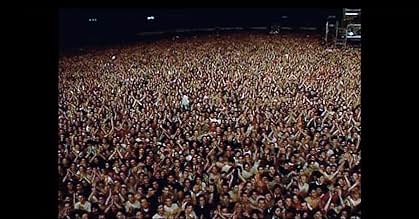IMDb रेटिंग
7.6/10
1.4 हज़ार
आपकी रेटिंग
तानाशाही, आपदाओं और असंतोष के माध्यम से लैटिन अमेरिकी रॉक के पचास साल के इतिहास को दर्शाया गया है.तानाशाही, आपदाओं और असंतोष के माध्यम से लैटिन अमेरिकी रॉक के पचास साल के इतिहास को दर्शाया गया है.तानाशाही, आपदाओं और असंतोष के माध्यम से लैटिन अमेरिकी रॉक के पचास साल के इतिहास को दर्शाया गया है.
एपिसोड ब्राउज़ करें
फ़ीचर्ड समीक्षाएं
This is a good initial overview, but misses too many scenes. The focus, as usual, is on Argentine and Mexican musicians, with an occasional nod to other countries. At times it is insightful, knowledgeable, and fair; they cover acts that were hits across the continent; and musicians that were clear innovators or influencers. Those parts were the best. They also cover the general history of Hispanic America, and many items that were relatable across countries. And they provide insights as to why rock bands from some countries got more exposure than their contemporaries from other countries; certain producers and etc.
But when they talk about generic bands that were not hits outside of their country (and misportrayed as 'everyone' was listening to them locally), it becomes annoying. Why not focus on acts from other countries that were more enduring in those cultures?
I wish they do a 2nd season or a follow-up series, and cover Brazil; Chicano rock; the ska rock, punk, pop rock, and political rock of Peru, Chile, and Central America; metal, post-rock, jazz rock, as well as the class division that created new musical genres (e.g. psychedelic rock fused with huayno becomes the super-popular andean chicha).
But when they talk about generic bands that were not hits outside of their country (and misportrayed as 'everyone' was listening to them locally), it becomes annoying. Why not focus on acts from other countries that were more enduring in those cultures?
I wish they do a 2nd season or a follow-up series, and cover Brazil; Chicano rock; the ska rock, punk, pop rock, and political rock of Peru, Chile, and Central America; metal, post-rock, jazz rock, as well as the class division that created new musical genres (e.g. psychedelic rock fused with huayno becomes the super-popular andean chicha).
Loved it. Very touching. It summarizes amanzingly how Rock en tu Idioma came to be. Really liked the format, following the timeline. Nowadays, many like to tell stories playing with flashbacks, going back and forth. I am glad this was not the case as I could remember it all as I lived it. I found it fast paced tho'... or maybe I was just enjoying too much.
I enjoyed the first part of the documentary, showing the early stages of rock, the political circumstances that model the artist. Then this documentary turns into cheap and gross propaganda of Gustavo Santaolalla bands.
In the part of the 90s to the actuality only talks about the commercial (complacent rock as Santaolalla says) and left behind the really popular bands like La Renga, Ataque 77, Callejeros (Only named for Cromagnon), Rata Blanca, and many others. The time dedicated to Los Redonditos and Pappo is insulting compared with other artists.
This is a documentary of commercial/complacent rock, not about popular rock.
In the part of the 90s to the actuality only talks about the commercial (complacent rock as Santaolalla says) and left behind the really popular bands like La Renga, Ataque 77, Callejeros (Only named for Cromagnon), Rata Blanca, and many others. The time dedicated to Los Redonditos and Pappo is insulting compared with other artists.
This is a documentary of commercial/complacent rock, not about popular rock.
No es un documental completo, pasan por alto muchas bandas que sentaron las bases del rock en latinoamerica. Es la historia de los grupos producidos por Sanaolalla, pero no es la historia del rock en Latinoamerica.
Hablan de influencia española sin mencionar a Heroes del Silencio u Hombres G? No tiene sentido.
Bueno para perder un par de horas, pero no esperen mucho.
If any given rock music fan wanted a comprehensive ride into Latin American rock since 1957, then this documentary is a must-see.
Yet they wouldn't only get just a chronicle. They 'd also catch a glimpse into some of, if not just the most traumatic decades of Latin America's fair share in the Cold War's social struggle and political abuse in America's backyard.
True that the stars and the constellations depicted after the opening eposodes in the chronology are Santaolalla's findings, but this by no means is an exhaustive account but a fair introduction into the force of rock and roll as it naturally thrived on the continent's woes. The music is just great. It explores the many forms rock can be reinvented when it hits context and genius reveals itself in unexpected fusions, subgenres and scenes.
टॉप पसंद
रेटिंग देने के लिए साइन-इन करें और वैयक्तिकृत सुझावों के लिए वॉचलिस्ट करें
विवरण
- रिलीज़ की तारीख़
- आधिकारिक साइट
- भाषा
- इस रूप में भी जाना जाता है
- Rompan todo: La historia del rock en América Latina
- उत्पादन कंपनी
- IMDbPro पर और कंपनी क्रेडिट देखें
- रंग
इस पेज में योगदान दें
किसी बदलाव का सुझाव दें या अनुपलब्ध कॉन्टेंट जोड़ें

![Tráiler [OV] देखें](https://m.media-amazon.com/images/M/MV5BMmMwNThjMzYtYmIwYi00ZDMzLWJkZjItZTRiNDQ3MjcyOGQ4XkEyXkFqcGdeQXRyYW5zY29kZS13b3JrZmxvdw@@._V1_QL75_UX500_CR0)




































